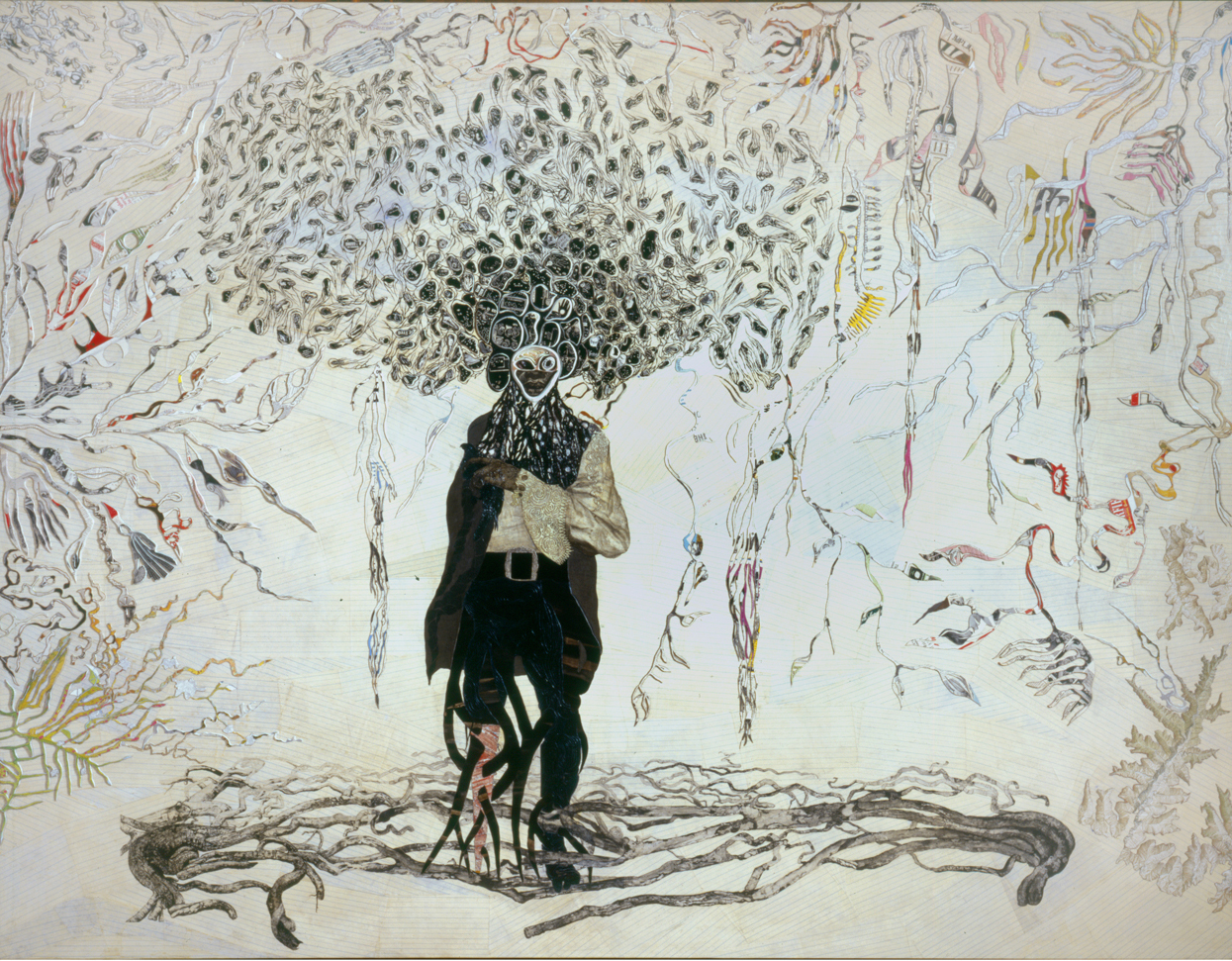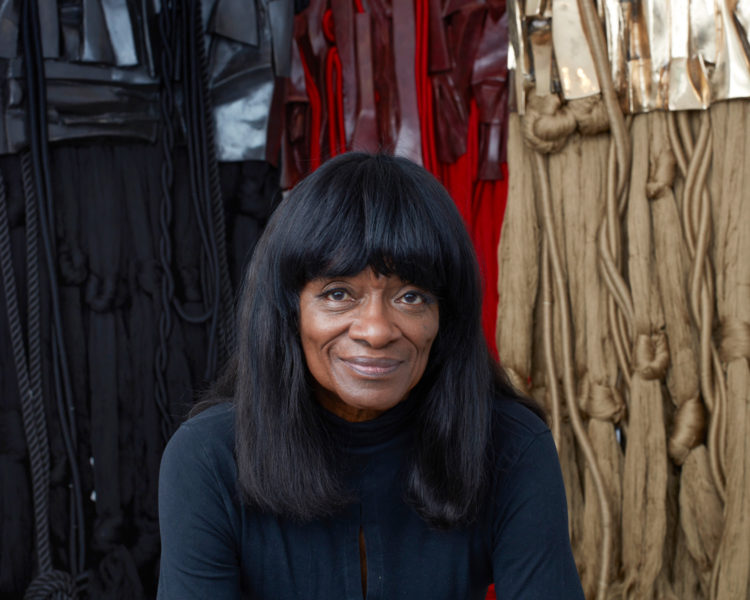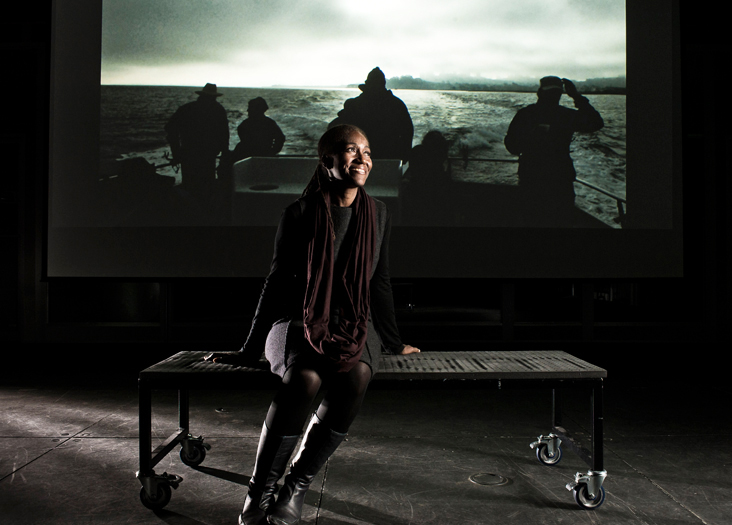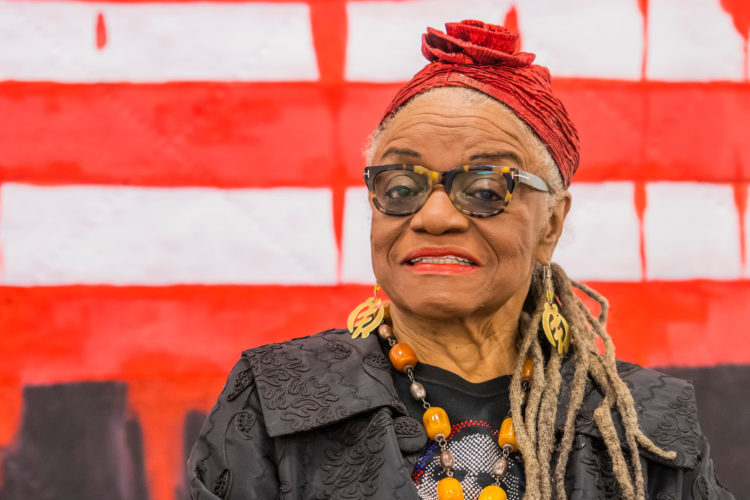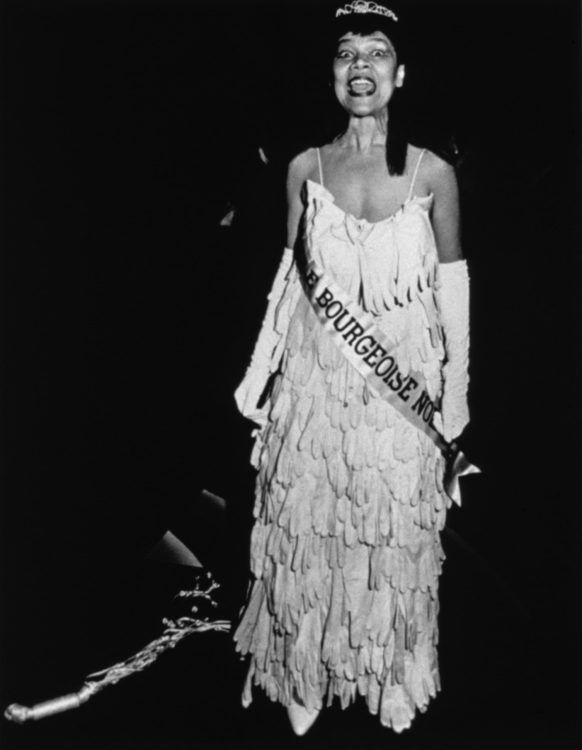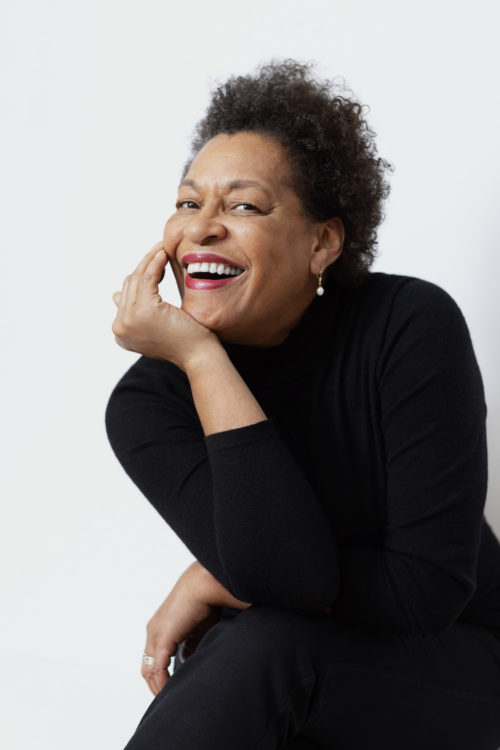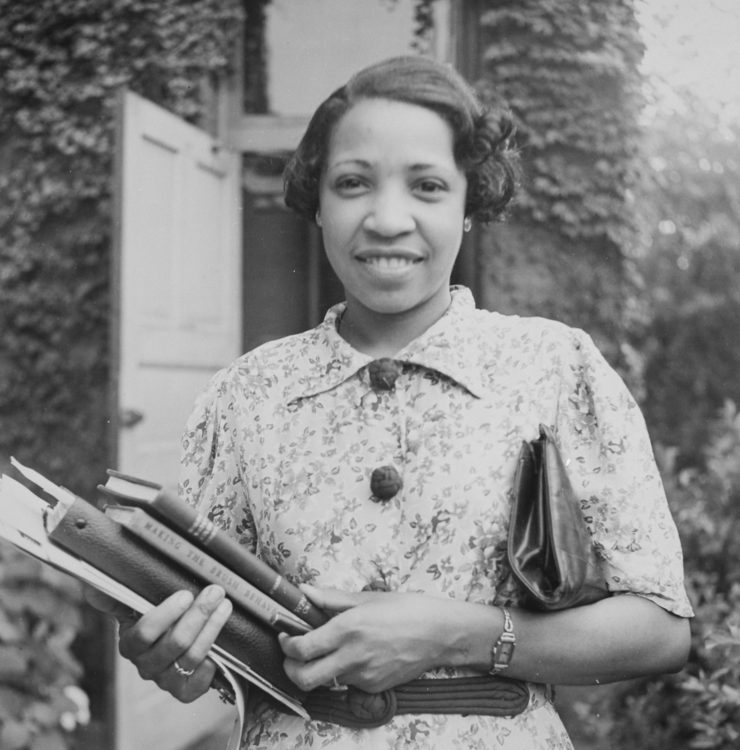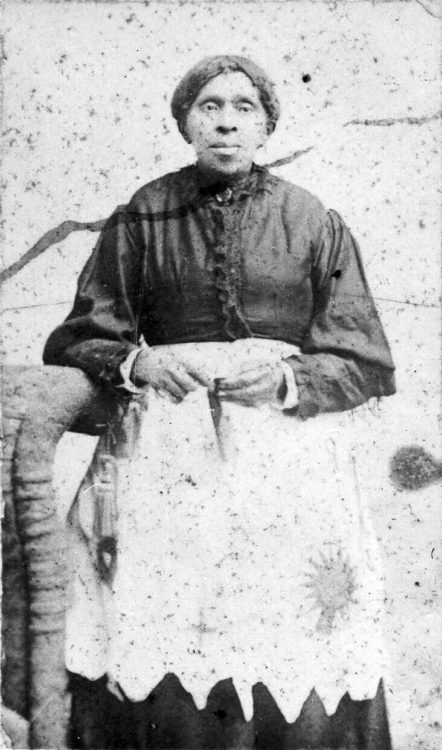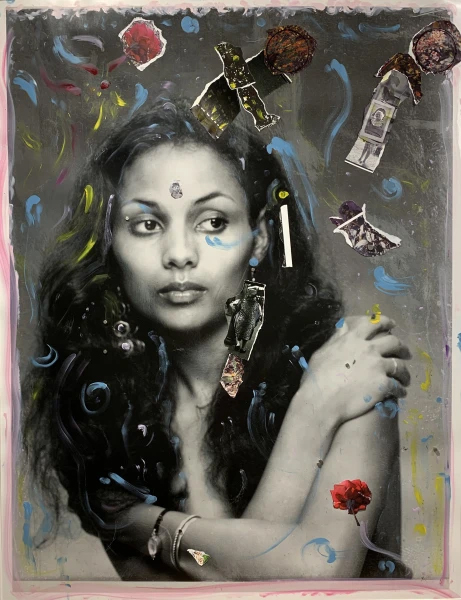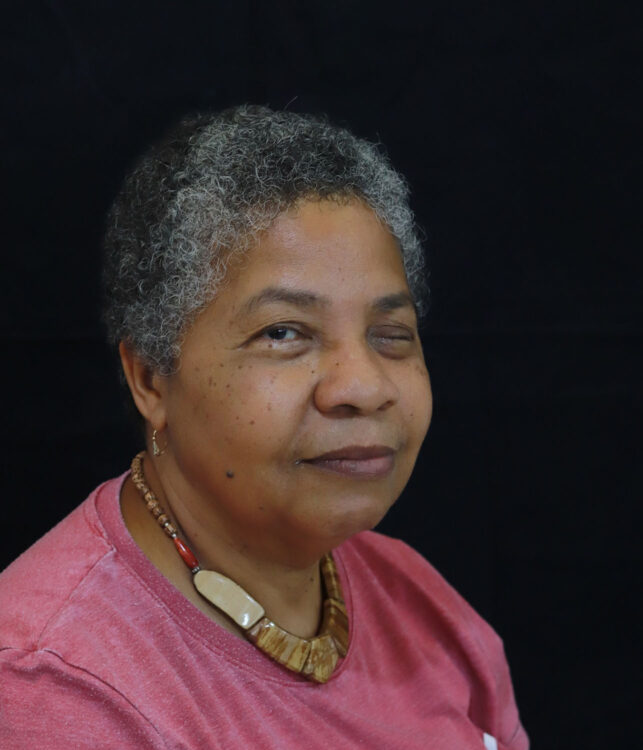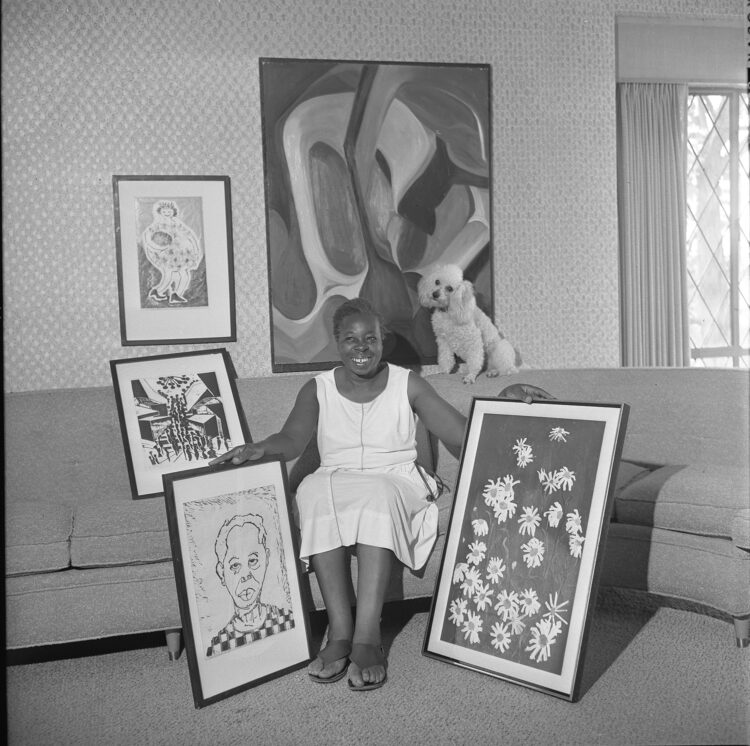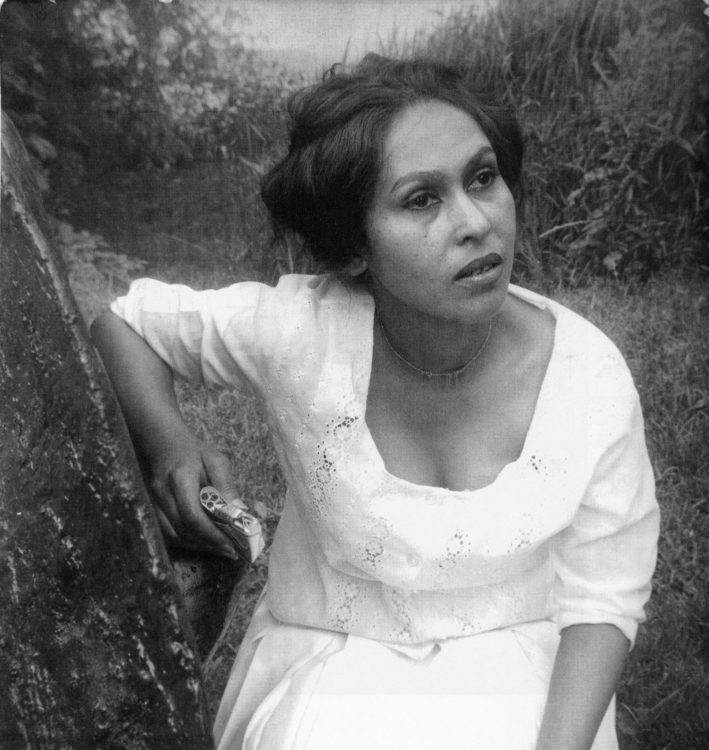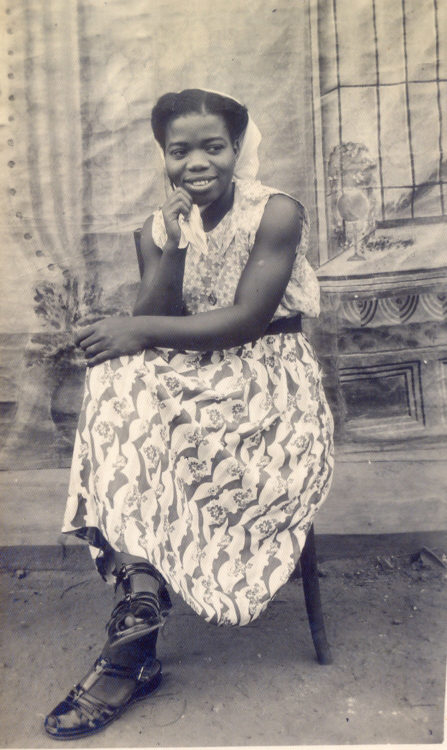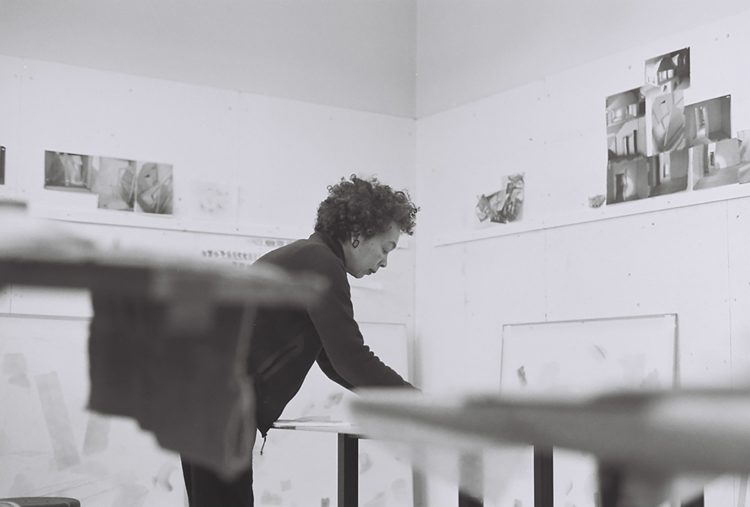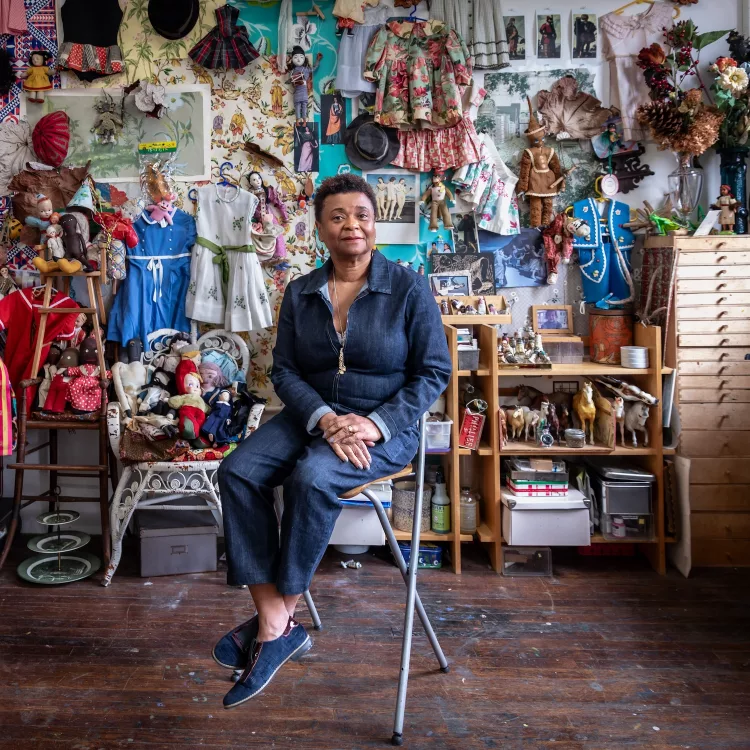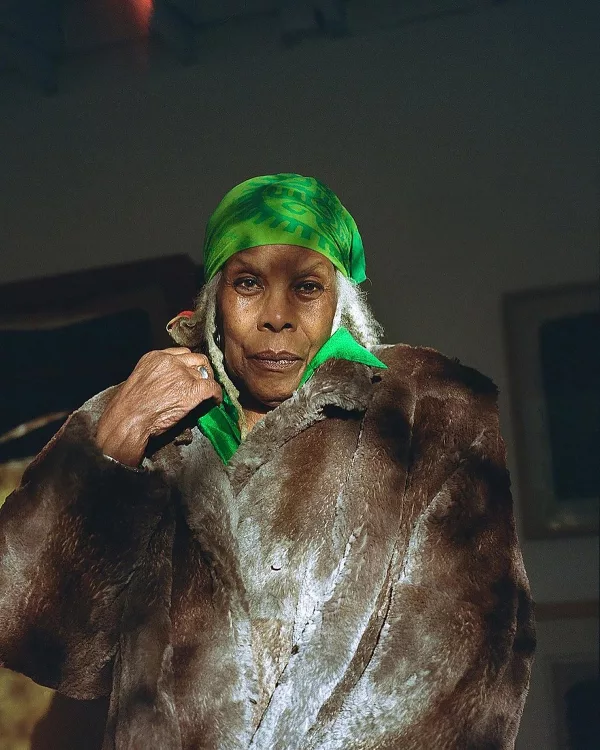Research
Ellen Gallagher, Bird in Hand, 2006, oil, pencil, gold leaf, plasticine and paper on canvas, 238 x 307 cm, 93 3/4 x 120 7/8 in., Courtesy Gagosian Gallery
Long under-represented in art history, African-American women artists have enjoyed increased visibility in recent years and have been the subject of a growing number of exhibitions and publications.1 This paradigm shift is part of a wider revolution happening within art and academic institutions, with the aim of moving the traditional canon beyond its Eurocentric and predominantly masculine version by supplementing it with art from around the world and more contributions by women artists.
Major French museums are also choosing to highlight a more inclusive art history by featuring Black content more prominently. Examples of this can be found in recent shows such as The Color Line. Les artistes africains-américains et la ségrégation, 1865-2016 at the Musée du Quai Branly – Jacques-Chirac in 2016, which marked the first time such a rich and unknown body of work was presented in France, and Le Modèle noir, de Géricault à Matisse at the Musée d’Orsay in 2019, which explored the representation of Black bodies in painting from 1794 to the present day.
Public institutional acquisitions ultimately contribute to form present, past and future canons, and these gradual changes in mindsets and attitudes towards artists who were historically ignored raise questions about their representation within permanent collections. The results of the aforementioned study stem from a combined analysis of online collections and of conversations with professionals working in the fields of art and culture.
The resulting database shows that since the 1970s, French institutions have acquired approximately fifty works from around ten African-American women artists (including a man/woman duo).
However, these institutions did not acquire any works by women artists from the two main 20th-century Black American art movements, the Harlem Renaissance and the Black Arts Movement. The artists whose works were acquired represent several generations: some are historical figures of contemporary art and established names in the art world for over forty years, such as Adrian Piper (born 1948) and Lorna Simpson (born 1960); others are up-and-coming younger artists, such as LaToya Ruby Frazier (born 1982) and Martine Syms (born 1988). While their artistic practices are far from uniform in nature, all of these artists share a common exploration of issues relating to identity, gender, memory, social class and Black culture.
Their works entered French collections through purchases (81%) and donations (19%). The most prominent art forms are photography (39%) and video (30%), which make up over half of the works identified, whereas painting is almost non-existent.

Technical distribution of works by African-American artists in French public collections, graph by the author
While these works are disseminated throughout national, regional and local institutions, the majority can be found in the three main French public contemporary art establishments: in Paris, the Musée National d’Art Moderne – Centre Georges Pompidou (MNAM) and the Centre National des Arts Plastiques (CNAP), and regionally, the Fonds Régionaux d’Art Contemporain (FRAC). Notably, the mission of these institutions is to share the diversity of artistic creation with the broadest public and to offer a reading of current and international art history.
Between the years 1970 and 2000 only three of these works were acquired. Two works by sculptor Barbara Chase-Riboud (born 1939), who has lived in France since 1960, entered the CNAP collections in 1972 and 1984. In 1974 she had a solo exhibition at the Musée d’Art Moderne de la Ville de Paris (MAMVP). In 1993 an installation on the colonial past of the city of Nantes by the artist Renée Green (born 1959) was purchased by the FRAC des Pays de la Loire following her 1991 participation in the 8th edition of the Ateliers internationaux, an artist residency programme which contributed to the collection’s expansion.
During the 2000s the majority of these acquisitions were made by the MNAM. The programming of exhibitions provided opportunities for the museum to complete its collections and to add new artists to their catalogue. Several of R. Green’s videos were therefore acquired by the New Media section following the exhibition Sonic Process, which focused on electronic music (2002). Parallel to this, in 2009-2011, elles@centrepompidou showcased women artists of all nationalities and prompted the presentation and acquisition of a photographic piece by L. Simpson thanks to a donation from Galerie Nathalie Obadia, which represented the artist at the time. It was also during the 2000s that several pieces by visual artist Kara Walker (born 1969), who enjoyed international visibility very early in her career, were added to the collections of various institutions, such as the Bibliothèque Nationale de France, the Artothèque in Villeurbanne and the MAMVP, who purchased one of the artist’s videos after hosting her travelling show, which was first held at the Walker Art Centre in Minneapolis, Kara Walker: My Complement, My Enemy, My Oppressor, My Love.2 A. Piper’s conceptual art made its way into the collections of the Institut d’art Contemporain Villeurbanne/Rhône-Alpes in 2003 with a polyptych of six photographs. That same year, the institute hosted a solo exhibition of her works, Depuis 1965.

Kara Walker, Gone, An Historical Romance of a Civil War as it Occurred between the Dusky Thighs of One Young Negress and Her Heart, 1994, cut paper on wall, installation variable dimensions, approx. 396.2 × 1,524 cm, 156 x 600 in., installation view: Selections 1994, The Drawing Center, New York, 1994, © photo: Orcutt Photo, Courtesy Kara Walker & Sikkema Jenkins & Co., New York, © Kara Walker
The vast majority of acquisitions (57%) were made in the years 2010-2020. This decade was overall more favourable to younger generations of artists, whose works were still low-priced on the art market and generally represented by a French gallery. Supported by the gallery Michel Rein in Paris, committed photographer L. R. Frazier was therefore the most represented of these artists, with her works acquired by no less than six institutions between 2012 and 2018. She also had her first travelling solo exhibition in France, which was presented at the Carré d’art – Musée d’Art Contemporain in Nîmes and CAPC Musée d’Art Contemporain in Bordeaux in 2015-2016. From the time he became the director of the Carré d’Art, curator Jean-Marc Prévost has steered the museum’s programming towards African-American issues and acquired works by young artists L. R. Frazier and M. Syms.
The under-representation of African-American women artists in permanent collections echoes the low proportion of works by female artists acquired by these institutions. In her research on the history of women in French national contemporary art collections (Fonds National d’Art Contemporain), curator and art historian Liberty Adrien noted that they had only accounted for 17.5% of the works acquired since 1960.3 Looking more closely at the Cnap’s acquisitions of American art, out of a total of over 1,000 works by 206 American women artists, there are only 5 African-American artists for a total of 14 works.4
In recent years female curators working at the MNAM and CNAP have mentioned the absence in national collections of major artists such as Faith Ringgold (1930-2024), Howardena Pindell (born 1943) and Ellen Gallagher (born 1965). However, it has now become harder to acquire pieces by these artists, either because they are not present in the institutional circuit or because they are too expensive due to their international notoriety and would have been more affordable fifteen years ago.

Adrian Piper, I am Somebody, The Body of My Friends #1-18, 1992-1995, 15 color photographs, 3 black and white photographs, unknown dimensions, Courtesy Adrian Piper Research Archive
A poor knowledge of these artists’ works and a lack of interest in the African-American scene as it was emerging are some of the possible reasons that could explain their under-representation. Specialists such as the contemporary art historian and critic Elvan Zabunyan, who has devoted more than twenty years to the study of African-American art, could contribute to the inclusion of their works if they were to become members of an acquisition committee. However, neither she nor other specialists have ever been invited to do so. In 2001 she did nonetheless curate the exhibition Love Supreme at La Criée in Rennes, which showed a selection of works by R. Green, Lorraine O’Grady (born 1934), Senga Nengudi (born 1943), A. Piper, L. Simpson and Carrie Mae Weems (born 1953).

Renée Green, Space Poem, 2007, 27 double-sided printed Dekotex banners, steel rope, steel tube and lugs, 105 x 80 cm each, © Photo: Natalie Czech, © Renée Green
In order to compensate for the insufficiencies of its annual acquisitions budget and soaring market prices, the MNAM relies on the support of patrons and donors who contribute to the enhancement of their collections. Thus a monumental painting by Julie Mehretu (born 1970), one of the most highly priced artists on the market, was added to the museum’s collection in 2019 thanks to a donation by the George Economou collection. In 2020 a new photograph by A. Piper entered French collections thanks to a donation by the American Friends of the Centre Pompidou. This foundation, which works closely with its French counterpart, Les Amis du Centre Pompidou, supports the development of acquisitions coming from the North American continent. Nonetheless, out of the 550 plus donations since 2010, A. Piper is the first African-American woman artist to be represented.
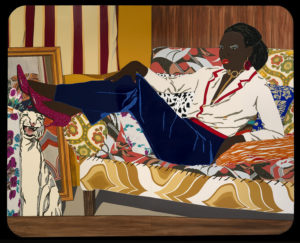
Mickalene Thomas, Hotter than July, 2005, acrylic, rhinestone and enamel on wooden panel, 152.4 x 182.9 cm, Rubbell Museum
A direct relationship with France or presence on its art scene does not necessarily equate the inclusion of works in its collections. Historical figures in particular are lacking, even though some of these have a unique history with the country, which welcomed Black American artists of all specialities during racial segregation in the United States.5 This is the case for sculptors Meta Vaux Warrick Fuller (1877-1968) and Nancy Elizabeth Prophet (1890-1960), and painter Loïs Mailou Jones (1905-1988), who lived, studied and exhibited in the French capital, and whose works deserve their rightful place in the country’s museums. Neither are more recent major figures of American contemporary art, such as Mickalene Thomas (born 1971) present in the collections, even though Galerie Nathalie Obadia, who represents her, devoted several exhibitions to her in Paris since 2014 and the Musée de l’Orangerie is hosting a solo exhibition of her works in 2022. For over twenty years her combined practice of painting and collage has questioned beauty standards and brought renewed visibility to Black women, who were reduced to secondary or peripheral roles in art history. In this sense, her paintings concluded the exhibitions The Color Line and Le Modèle Noir. Yet her works had been put forward to an acquisition committee at a lower price than those of other African-American artists already listed in the collections. M. Thomas’s absence more generally reflects that of Black figurative painting in public contemporary art collections, despite the fact that many contemporary African-American artists have brought back narrative figuration to the foreground as a response to their centuries-long lack of representation in Western painting.
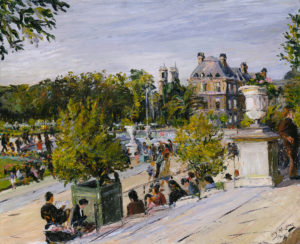
Lois Mailou Jones, Jardin du Luxembourg, ca. 1948, oil on canvas, 60.5 x 73 cm, © Smithsonian American Art Museum
Many new pieces will most certainly enter the collections and make up for this absence in the present decade, which began with the introduction of a central figure of contemporary American photography, Deana Lawson (born 1979), into the CNAP collections in 2021. While the increase in acquisitions between 2000s and 2010s is positive, it still remains marginal compared to the global scale of purchases of American art and the numerous African American women artists with little or no representation.
“Black (also) matters (in art)”, 2000-2020 Artprice report: https://fr.artprice.com/artprice-reports/le-marche-de-lart-contemporain-2020/black-also-matters-in-art.
2
Shown from 17 February to 13 May 2007 at the Walker Art Centre; 20 June to 9 September 2007 at the MAMVP; 11 October 2007 to 3 February 2008 at the Whitney Museum of American Art in New York; 2 March to 8 June 2008 at the Hammer Museum in Los Angeles; and 6 July to 19 October 2008 at the Museum of Modern Art in Forth Worth.
3
Adrien Liberty, Pollet Juliette and Chênel Marie, “La Houle : une première recherche sur la place des femmes dans les collections du Centre national des arts plastiques”, AWARE Magazine (11 December 2019).
4
American art acquisitions account for 3.5% of artists in the CNAP collections, accounting for 4.6% of the works.
5
Tyler E. Stovall, Paris Noir, African Americans in the City of Light (Boston, MA: Houghton Mifflin, 2012).
Kelly-Christina Grant, "African-American Women Artists in French Public Collections: Acquisitions from the 1970s to the Present Day." In Archives of Women Artists, Research and Exhibitions magazine, . URL : https://awarewomenartists.com/en/magazine/artistes-afro-americaines-dans-les-collections-publiques-francaises-acquisitions-institutionnelles-des-annees-1970-a-nos-jours/. Accessed 15 January 2026
